Property developers are providing more than just homes for humans, with a blueprint for pollinator districts created by Westminster's Butterfly Pavilion.
The Butterfly Pavilion has drawn up innovative ways that we can integrate pollinator habitats into our neighborhoods — and initial results suggest that they are helping to restore dwindling bee and butterfly numbers.
What are pollinator districts?
Pollinator districts are areas designated both for conserving pollinator populations and for educating local residents about their value to the planet.
Working with property developers, the Butterfly Pavilion integrates pollinator habitats into manmade green areas, like roof gardens, sidewalk edgings, public parks, and residential neighborhoods.
Some interventions include adding native shrubs that pollinators can feed on, designing gardens that resemble pollinator habitats (with a variety of wildflowers, open ground, and a passive water source), and teaching locals in the area the fundamentals of beekeeping.
These flower-rich areas, busy with bees and butterflies, are made to demonstrate the desirability of a sustainable lifestyle to local residents.
Helping to reinforce this message are educational outreach programs, including workshops, classes, and opportunities for volunteering.
Why are pollinator districts important?
One of every three bites of our food is made with the assistance of pollinating insects, whose numbers are now falling across the globe.
Between 2006 and 2015, 25% fewer species of bees were spotted around the world compared with numbers reported before the 1990s.
Butterflies are suffering a similar fate. For the past four decades, more than 450 species of butterflies have seen a population decline of almost 2% every year.
That drop is already having a measurable impact on food production. One study found that the amount of fruits, vegetables, and nuts that we can grow has decreased by 3-5% because of a loss of pollinators.
Part of the reason that we are losing pollinating insects at this rate is because of disappearing habitats, so it stands to reason that pollinator districts could help to reverse the decline.
Initial data from Baseline, a residential area in Broomfield that has incorporated pollinator districts, suggests that in just three years (between June 2019 and September 2022), the number of pollinator species and families in the area grew by 63%.
"It's just really inspiring because it just shows that if you build it, they'll come," Amy Yarger, horticulture director for Butterfly Pavilion, told Westminster Window.
"They are foundational to our overall food supply. There is a need for action now," Kyle Harris, Baseline's general manager said to Cobiz Mag.
Building the ultimate pollinator district
The Butterfly Pavilion is the world's only Association of Zoos and Aquariums-accredited invertebrate zoo, and it is currently planning a move to a new hub in Broomfield, Colorado.
The organization's new research and learning center will be the world's first development that is built with pollinators as its focal point.
Pollinator habitats will integrate seamlessly with homes, schools, shops, and restaurants to be used both by locals and visitors to the center.
The $55 million, 80,000-square-foot plan features habitat gardens in parks, retail areas with embedded planter boxes, and a roof where plants can be grown.
The Butterfly Pavilion plans to move to its new facility by 2025.
Join our free newsletter for cool news and cool tips that make it easy to help yourself while helping the planet.









